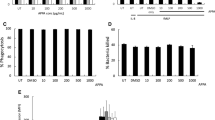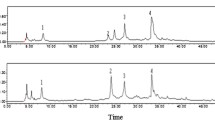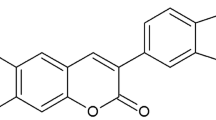Abstract
In this study the anti-inflammatory potential of potassium humate, derived from bituminous coal, has been investigated in vitro. Exposure of resting and phorbol-12-myristate-13-acetate (PMA) stimulated human neutrophils to potassium humate resulted in a decreased expression of CR3 by activated, but not resting cells, in a dose-related way. Humate also inhibited the adhesion of PMA-stimulated neutrophils to a baby hamster kidney cell line expressing ICAM1 (the CR3 ligand) (BHK331-7). Similar results were obtained using normal BHK cells indicating that this inhibition does not only target specific adhesion molecules on the neutrophil and eosinophil membrane by activated phagocytes, but also affects other mechanisms involved in cell adhesion. Opsonised Sephadex or FMLP/Cyto B-induced degranulation of neutrophils and eosinophils were also decreased by humate treatment. Inhibition of the adhesion of activated phagocytes, as well as inhibition of the release of granule polypeptides, both of which are responsible for tissue damage during inflammatory processes, are attractive targets for anti-inflammatory drugs. Because humate is well tolerated with an excellent safety profile it merits further evaluation in patients suffering from inflammatory conditions.
Similar content being viewed by others
REFERENCES
Hartenstein, R. 1981. Sludge decomposition and stabilization. Science 212:743-749.
Visser, S. A. 1973. Some biological effects of humic acids in the rat. Acta. Biol. Med. Germ. 31:569-581.
Baatz, H. 1988. Moortherapie en der Frauenheilkunde. In: Moortherapie: Grundlagen und Anwendungen, W. Flaig, C. Goecke, and W. Kauffels, eds. Ueberreuter, Wien-Berlin, pp. 161-168.
Kleinschmidt, J. 1988. Moortherapie bei rheumatischen Erkrankungen. In: Moortherapie: Grundlagen und Anwendungen, W. Flaig, C. Goecke, and W. Kauffels, eds. Ueberreuter, Wien-Berlin, pp. 216-224.
Kovarik, R. 1988. Über die Anwendung von Präparaten aus Torf, bzw. Huminstoffen bei gynäkologischen Erkrankungen. In: Moortherapie: Grundlagen und Anwendungen, W. Flaig, C. Goecke, and W. Kauffels, eds. Ueberreuter, Wien-Berlin, pp. 177-197.
Lent, W. 1988. Bericht über die Moorforschung und anwendung in der DDR, Polen, Tschechoslowakei und UdSSR. In: Moortherapie: Grundlagen und Anwendungen, W. Flaig, C. Goecke, and W. Kauffels eds. Ueberreuter, Wien-Berlin, pp. 169-176.
Goel, R. K., R. S. Banerjee, and S. B. Acharya. 1990. Antiulcerogenic and antiinflammatory studies with Shilajit. J. Ethnopharmacol. 29:95-103.
Schepetkin, I., A. Khlebnikov, and B. S. Kwon. 2002. Medical drugs from humus matter: Focus on Mumie. Drug Dev. Res. 57:140-159.
Soliev, T. S. 1983. The treatment of deforming osteoarthrosis by non-specific bio-stimulator Mumie. Med. J. Uzbek 8:19-21.
Cloete, T. E., H. Swart, I. J. Cronje, and J. Dekker. 1990. Oxidized coal products as industrial bactericides. In: Third International Symposium on Gas, Oil, Coal and Environmental Biotechnology, New Orleans, Louisiana, December 3-5.
van Rensburg, C. E. J., A. van Straten, and J. Dekker. 2000. An in vitro investigation of the antimicrobial activity of oxifulvic acid. J. Antimicrob. Chemother. 46:853-854.
van Rensburg, C. E. J., S. C. K. Malfeld, and J. Dekker. 2002. Topical application of oxifulvic acid suppresses the cutaneous immune response in mice. Chemotherapy 48:138-143.
Snyman, J. R., J. Dekker, S. C. K. Malfeld, and C. E. J. van Rensburg. 2002. A pilot study to evaluate the safety and therapeutic efficacy of topical oxifulvic acid in atopic volunteers. Drug Dev. Res. 57:40-43.
Jooné, G. K., J. Dekker, and C. E. J. van Rensburg. 2003. Investigation of the immunostimulatory properties of oxihumate. Z. Naturforsch. Redaktion. 58:263-267.
Bansal, V. S., S. Vaidya, E. P. Somers, M. Kanuga, D. Shevell, R. Weikel, and P. A. Detmers. 2003. Small molecule antagonists of complement receptor type 3 block adhesion and adhesion-independent oxidative burst in human polymorphonuclear leukocytes. J. Pharmacol. Exp. Ther. 1016-1024.
Håkanson, L., M. D. Björnsson, C. Janson, and M. D. Schmekel. 1995. Increased adhesion to vascular cell adhesion molecule-1 of eosinophls from patients with asthma. J. Allergy Clin. Immunol. 96:941-950.
Ballesteros, J. F., M. J. Sanz, A. Ubeda, M. A. Miranda, S. Iborra, M. Paya, and M. J. Alcaraz. 1995. Synthesis and pharmacological evaluation of 2′-hydroxychalcones and flavones as inhibitors of inflammatory mediators generation. J. Med. Chem. 38:2794-2797.
Blackburn, W. D., Jr., L. W. Heck, L. D. Loose, J. D. Eskra, and T. J. Carty. 1991. Inhibition of 5-lipoxygenase product formation and polymorphonuclear cell degranulation by tenidap sodium in patients with rheumatoid arthritis. Arthritis Rheum. 34:204-210.
Spisani, S. S. Traniello, A. M. Onori, C. Martuccio, and L. Cellai. 1998. 3-(Carboxalkylthio) rifamycin S and SV derivatives inhibit human neutrophil functions. Inflammation 22:459-469.
Bergh, J. J., I. J. Cronje, J. Dekker, T. G. Dekker, L. M. Gerritsma, and L. J. Mienie. 1997. Non-catalytic oxidation of water-slurried coal with oxygen: Identification of fulvic acids and acute toxicity. Fuel 76:149-154.
Piccolo, A., P. Conte, and A. Cozzolino. 2000. Differences in high performance size exclusion chromatography between humic substances and macromolecular polymers. In: Humic Substances: Versatile Components of Plants, Soils and Water, E. A. Ghabbour and G. Davies, eds. Royal Society of Chemistry, Cambridge, UK, pp. 111-124.
Håkanson, L., L. S. Nielson, and P. Teder. 1994. Measurement of neutrophil and eosinophil adhesion to E-selectin, VCAM-1 and ICAM-1 by the use of transfected fibroblast cell lines. J. Immunol. Methods 176:53-66.
Böyum, A. 1968. Isolation of leucocytes from human blood. Further observations: Methylcellulose, dextran, and ficoll as erythrocyte aggregating agents. Scand. J. Clin. Lab. Invest. 21:31-50.
Ras, G. J., R. Anderson, G.W. Taylor, J. E. Savage, E. van Niekerk, G. Joone, H. J. Koornhof, J. Saunders, R. Wilson, and P. J. Cole. 1992. Clindamycin, erythromycin, and roxithromycin inhibit the proinflammatory interactions of Pseudomonas aeruginosapigments with human neutrophils in vitro. Antimicrob. Agents Chemother. 36(6):1236-1240.
Weiss, S. J. 1989. Tissue destruction by neutrophils. N. Engl. J. Med. 320:365-376.
Jaeschke, H., A. Farhood, A. P. Bautista, Z. Spolarics, J. J. Spitzer, and C. W. Smith. 1993. Functional inactivation of neutrophils with Mac-1 (CD11b/CD18) monoclonal antibody protects against ischemia-reperfusion injury in rat liver. Hepatology 17:915-923.
Jaeschke, H., A. Farhood, and C. W. Smith. 1991. Neutrophil induced liver cell injury in endotoxin shock is a CD11b/CD18-dependant mechanism. Am. J. Physiol. 261:G1051-G1056.
Burch, R. M., M. Weitzberg, L. Noronha-Blob, V. C. Lowe, J. M. Bator, J. Perumattam, and J. P. Sullivan. 1992. Leumedins. Drug News Prospect. 5:331-337.
Stadnyk, A. W., D. Dollard, T. B. Issekutz, and A. C. Issekutz. 2002. Neutrophil migration into indomethacin induced rat small intestinal injury is CD11a/CD18 and CD11b/CD18 co-dependant. Gut 50:629-635.
Ramamoorthy C., S. S. Sasaki, D. L. Su, S. R. Sharar, J. M. Harlan, and R. K. Winn. 1997. CD18 adhesion blockade decreases bacterial clearance and neurophil recruitment after intrapulmonary E. colibut not S. aureus. J. Leukoc. Biol. 61:167-172.
Klebanoff, S. J. and R. A. Clark. 1978. The Neutrophil: Functions and Clinical Disorders. Elsevier Scientific, Amsterdam.
Venge P. 1990. The human eosinophil in inflammation. Agents Actions 29:122-126.
Nègre, M., H. R. Schulten, M. Gennari, and D. Vindrola. 2001. Interaction of imidazolinone herbicides with soil humic acids. Experimental results and molecular modeling. J. Environ. Sci. Health, Part B 36:107-125.
Sato, T., Y. Ose, H. Nagase, and K. Hayase. 1987. Adsorption of mutagens by humic acid. Sci. Total Environ. 62:305-310.
Cozzi, R., M. Nicolai, P. Perticone, R. De Salvia, and F. Spuntarelli. 1993. Desmutagenic activity of natural humic acids: Inhibition of mitomycin C and maleic hydrazide mutagenicity. Mutat. Res. 299:37-44.
Botes, M. E., J. Dekker, and C. E. J. van Rensburg. 2002. Phase I trial with oral oxihumate in HIV-infected patients. Drug Dev. Res. 57:34-39.
Author information
Authors and Affiliations
Rights and permissions
About this article
Cite this article
Jooné, G.K., van Rensburg, C.E.J. An In Vitro Investigation of the Anti-Inflammatory Properties of Potassium Humate. Inflammation 28, 169–174 (2004). https://doi.org/10.1023/B:IFLA.0000039563.90066.5d
Issue Date:
DOI: https://doi.org/10.1023/B:IFLA.0000039563.90066.5d




